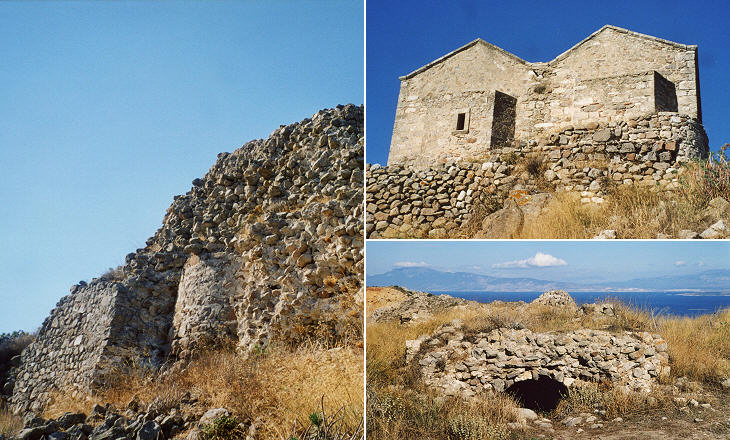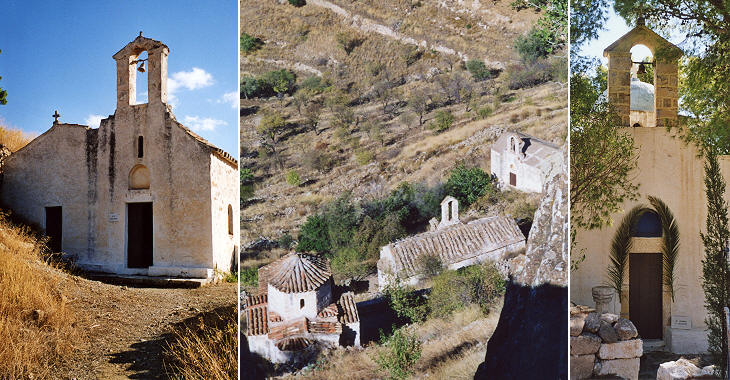  What's New! Detailed Sitemap All images © by Roberto Piperno, owner of the domain. Write to romapip@quipo.it. Text edited by Rosamie Moore. Page added in 2002. |
  Egina (Aegina) Egina (Aegina)
Key dates: 1204 Frankish (Catalan) occupation of the island following the conquest of Constantinople by the Fourth Crusade 1451 Venetians took over from the Catalans 1540 Venice ceded Aegina to the Turks at the end of the third Venetian-Turkish war (1537-40) 1654 Brief occupation by Francesco Morosini during the War of Candia 1687 Permanent occupation by the Venetians 1714 Return of the Turks 1821 Revolt against the Turks. In 1828 Egina was for a short period the capital of Greece. Egina (Aegina) is an island located at the center of what is today called Saronikos Gulf, which was called in the past Gulf of Egina. A little cove at its north-western tip provided an excellent harbour which in the VIth century BC was unrivalled in the area. The building by Themistocles of Piraeus, which provided Athens with a harbour led to several wars between the Aeginians and the Athenians. In ancient times the town of Egina was located on a little hill to the north of the natural harbour. It was protected by walls by Attalos I, King of Pergamos, who acquired the island in 211 BC. In 133 BC Attalos III donated Pergamos (and Egina) to the Romans.
In medieval times the island was often looted by pirates and its inhabitants were sold as slaves. Over time the site to the north of the harbour was abandoned in favour of a location to the south of it. A medieval tower (strengthened by the Venetians during their second occupation) protected the harbour until recent times when it was pulled down to expand the port facilities of Egina. Its cannons are still on the jetty and they are pointed towards the only surviving column of a Temple of Apollo. In 896 the Saracen pirates raided Egina (at the time part of the Byzantine Empire) several times and the inhabitants abandoned the area around the harbour and built a new town on a hill inland. For nearly 1000 years this town was named Egina. The town was protected by a small castle at the top of the hill. In the XVIIIth century its inhabitants slowly abandoned it to rebuild the town near the harbour. Today the site is called Paleo Chora (old town).
The castle was strengthened by the Venetians during their second occupation, but in 1714 the small Venetian garrison gave up without fighting. Its members were mainly mercenaries and the Turkish army which invaded Egina was very large. The peace of Passarowitz in 1718 gave the Turks full control of the Aegean Sea, so they did not maintain the castle, of which today little is left.
According to the tourist guides Paleo Chora had 365 churches. Certainly it had a lot of small churches, very often twin churches for the population was made of Catholic and Orthodox believers. The piety of the inhabitants of Egina has preserved some forty churches.
Several churches retain interesting frescoes showing both Byzantine and western aspects. The lintels of the churches are decorated with different kinds of crosses and other religious symbols. The church of St George retains a 1533 inscription making reference to the Venetian governor of Napoli di Romania who had jurisdiction over Egina.
The hill of Paleo Chora is not the highest peak of the island, but it had a good view of the harbour and of the coast of Attica and Athens (today always covered by a cloud of smog).
Although this page is devoted to the Venetian period of Egina, it would be unforgivable not to mention the Temple of Aphaea, a sanctuary built on the north eastern part of the island, from which both the Parthenon and the Temple of Cape Sounion are in sight. The site was excavated in 1811 and many sculptures were found which were eventually bought by the King of Bavaria (they are now in Munich). The Doric temple is dedicated to Aphaea, which means the invisible/ the vanishing one, a name given to Britomartis of Gortyna, daughter of Leto, who was pursued by Minos, King of Crete. Britomartis hid from Minos for nine months until, in desperation, she threw herself into the sea and she was hauled to safety by fishermen of Egina, where she found refuge in the woods.
Excerpts from Memorie Istoriografiche del Regno della Morea Riacquistato dall'armi della Sereniss. Repubblica di Venezia printed in Venice in 1692 and related to this page:
Introductory page on the Venetian Fortresses Pages of this section: On the Ionian Islands: Corfù (Kerkyra) Paxo (Paxi) Santa Maura (Lefkadas) Cefalonia (Kephallonia) Asso (Assos) Itaca (Ithaki) Zante (Zachintos) Cerigo (Kythera) On the mainland: Butrinto (Butrint) Parga Preveza and Azio (Aktion) Vonizza (Vonitsa) Lepanto (Nafpaktos) Atene (Athens) On Morea: Castel di Morea (Rio), Castel di Rumelia (Antirio) and Patrasso (Patra) Castel Tornese (Hlemoutsi) and Glarenza Navarino (Pilo) and Calamata Modon (Methoni) Corone (Koroni) Braccio di Maina, Zarnata, Passavà and Chielefà Mistrà Corinto (Korinthos) Argo (Argos) Napoli di Romania (Nafplio) Malvasia (Monemvassia) On the Aegean Sea: Negroponte (Chalki) Castelrosso (Karistos) Oreo Lemno (Limnos) Schiatto (Skiathos) Scopello (Skopelos) Alonisso Schiro (Skyros) Andro (Andros) Tino (Tinos) Micono (Mykonos) Siro (Syros) Egina (Aegina) Spezzia (Spetse) Paris (Paros) Antiparis (Andiparos) Nasso (Naxos) Serifo (Serifos) Sifno (Syphnos) Milo (Milos) Argentiera (Kimolos) Santorino (Thira) Folegandro (Folegandros) Stampalia (Astipalea) Candia (Kriti) You may refresh your knowledge of the history of Venice in the Levant by reading an abstract from the History of Venice by Thomas Salmon, published in 1754. The Italian text is accompanied by an English summary. Clickable Map of the Ionian and Aegean Seas with links to the Venetian fortresses and to other locations (opens in a separate window) |






